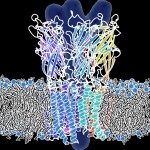Link to Pubmed [PMID] – 12126621
Link to HAL – Click here
Link to DOI – 10.1016/s0022-2836(02)00562-4
J Mol Biol. 2002 Jul 26;320(5):1011-24.
The Elastic Network Model is used to investigate the open/closed transition in all DNA-dependent polymerases whose structure is known in both forms. For each structure the model accounts well for experimental crystallographic B-factors. It is found in all cases that the transition can be well described with just a handful of the normal modes. Usually, only the lowest and/or the second lowest frequency normal modes deduced from the open form give rise to calculated displacement vectors that have a correlation coefficient larger than 0.50 with the observed difference vectors between the two forms. This is true for every structural class of DNA-dependent polymerases where a direct comparison with experimental structural data is available. In cases where only one form has been observed by X-ray crystallography, it is possible to make predictions concerning the possible existence of another form in solution by carefully examining the vector displacements predicted for the lowest frequency normal modes. This simple model, which has the advantage to be computationally inexpensive, could be used to design novel kind of drugs directed against polymerases, namely drugs preventing the open/closed transition from occurring in bacterial or viral DNA-dependent polymerases.

